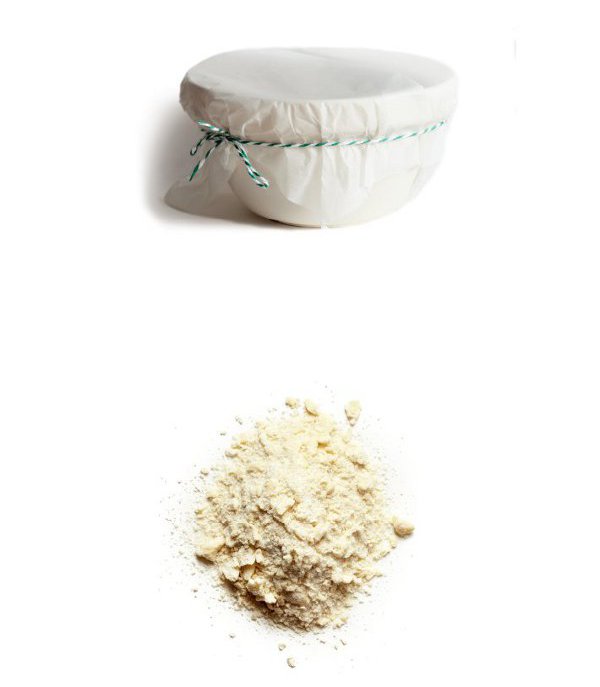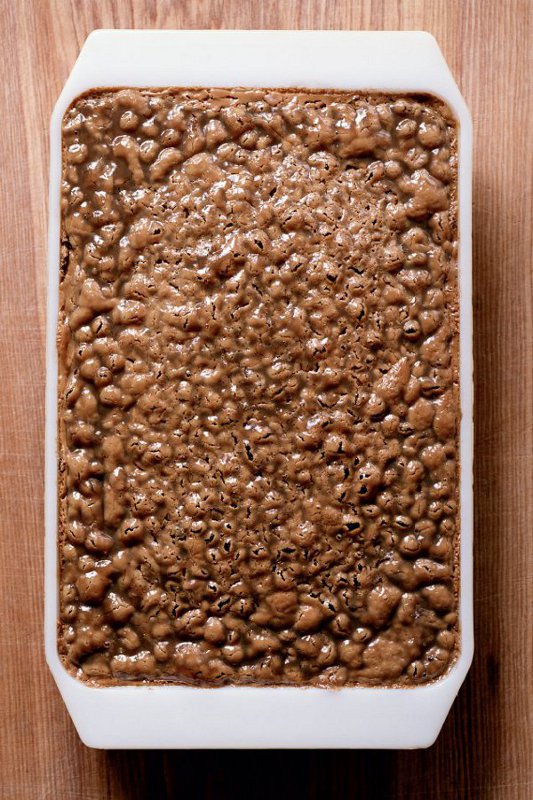Good Cook (24 page)
Authors: Simon Hopkinson


four puddings & a crumble
serves 6
6 oz dried figs, chopped
4 oz sultanas
4 oz ginger preserve (or ginger marmalade), warmed until melted
1 tbsp sweet sherry or Madeira
1 tbsp Cognac
grated zest and juice of 1 small lemon
grated zest and juice of 1 small orange
2
/
3
cup self-raising flour
½ rounded tsp baking powder
good pinch of salt
3 oz fresh white breadcrumbs
3 oz suet
2 oz ground almonds
1 rounded tsp mixed spice
2 small eggs
2–3 tbsp milk
softened butter, for greasing
3 tbsp golden syrup
for the rum sauce
4 tbsp butter
4 tbsp all-purpose flour
12 oz cold milk
tiny pinch of salt
2–3 oz golden superfine sugar, to taste
2–3 tbsp dark rum
2 oz whipping cream
It is not often one finds dried figs in a pudding, but they have a really rich flavor and a delicious, almost crunchy texture from the seeds within. Naturally, this always reminds me of the old-fashioned fig rolls we were given as children; not the most exciting of biscuits compared with other more chocolatey biscuits, but they may have made us “regular,” at least …
Put the figs and sultanas into a bowl with the warmed ginger preserve, sherry or Madeira, Cognac, and the zest and juice of the lemon and orange. Leave for 1 hour to allow the fruits to soak up the alcohols.
Put the flour, baking powder, salt, breadcrumbs, suet, almonds and spice into, preferably, the bowl of an electric mixer. Beat the eggs together in a small bowl and stir into the soaked fruit. Switch on the machine at its lowest speed, then slowly pour in the egg/soaked fruit mixture until well mixed. Turn up the speed just a little, add some of the milk, and beat together for a minute or two, until a “dropping” consistency is achieved when you lift out the beater.
Generously butter a 1-quart capacity pudding basin, pour in the syrup and, using a palette knife or spatula, spread the syrup right up the sides of the basin to coat it completely. Quickly pour the mixture into the basin and smooth the surface. Make a pleat across the center of a lightly buttered sheet of kitchen foil (to allow for expansion), then wrap it around the top of the basin and tie with string. Place the pudding in a large saucepan (or steamer) and add enough water to come a third of the way up the basin. Put a lid on the pan, bring up to a simmer, and steam for 2 hours, checking now and then to ensure that the pan does not boil dry. Remove from the heat, turn the pudding out on to a warm serving dish and serve with the following rum sauce.
To make the sauce, take a small saucepan and in it melt the butter over a moderate heat. Stir in the flour until blended and quietly cook together for about a minute, keeping the mixture pale. Using a whisk, add the milk all in one go, mixing it in with vigor, until all is smooth. Continue whisking, more quietly now, until beginning to thicken, then switch to a wooden spoon, but continue stirring until fully thickened, for several more minutes. Add the salt, sugar and rum and, after a few more minutes, stir in the cream and bring to a final simmer. Keep warm, covered, until ready to serve with the pudding.
serves a greedy 4, or a more
parsimonious 6
softened butter, for greasing
approx. 2 tbsp demerara sugar
a little semi-skimmed (2% fat) milk
clotted cream
for the suet pastry
1
2
/
3
cups self-raising flour
6 oz suet
¼ tsp salt
2 oz fresh white breadcrumbs
½ tsp baking powder
4½–5 oz semi-skimmed (2% fat) milk
for the filling
4 sweet apples (approx. 1¼ lb, peeled and
grated
grated zest and juice of 1 small lemon
7 oz mincemeat
pinch of ground cloves
big pinch of cinnamon
½ tsp ground ginger
1 tbsp Calvados (or Cognac)
Over the past few years, I have been taking the trouble to obtain fresh suet from an enterprising good butcher. Whenever he buys kidneys (either from veal or beef, but not lamb; too strong for puddings), I ask for the suet, bring it home and put it through a mincer. I then freeze it in plastic bags in 180g amounts. It is then ready to use, direct from frozen.
The suet from around the kidney is the finest, in my view. Also, it produces the lightest suet pastry I know, together with a special flavor and richness. Do a little research and I feel sure you will be able find some from an accommodating butcher, somewhere. Otherwise, it will be have to be from those little red and yellow boxes, which are fine; just not quite the same.
Mix together the first 5 pastry ingredients in a large bowl (or in the bowl of an electric mixer, with the flat beater) using your hands. Add at least 4½ oz of the milk to achieve a cohesive mass, adding a little more if it is too sticky. Knead for a few
minutes until it feels supple. Flatten to a fat disc and allow to relax for 30 minutes in the fridge. Meanwhile, to make the filling, simply mix all the ingredients together in a bowl and put to one side.
Roll out the pastry thickly, about ¼ in, ending up with a large circle. Cut a wedge out of this circle (about a quarter) and put it to one side.
Now, thickly grease a 1-quart pudding basin with plenty of softened butter, then sprinkle over the demerara sugar and, moving the bowl around with your hands, allow the sugar to stick to the butter all over. Shake out any excess. Fit the pastry into the basin neatly and join it up, if possible, without too many wrinkles. Roll out the cut-out wedge, along with any trimmings from the large circle (once you have fitted it into the basin) to form a smaller circle for the lid.
Fill the pastry-lined bowl with the apple/mincemeat mixture, brush the edges of the pastry with milk, fix on the pastry lid and make a couple of holes in the top with a small knife, for steam to escape. As in the previous recipe, make a pleat across the center of a lightly buttered sheet of kitchen foil (to allow for expansion), then wrap it around the top of the basin and tie with string. Place the pudding in a large saucepan (or steamer) and add enough water to come a third of the way up the basin. Put a lid on the pan and bring up to a simmer. This time, steam the pudding for 3 hours (suet pastry needs a longer cooking time), checking now and then to ensure that the pan does not boil dry.
Once cooked, turn the pudding out on to a hot serving dish and hand a lovely big bowl of clotted cream to melt over each serving.
serves 6
for the pudding
9 oz boiling water
6 oz ready-chopped dates
1 rounded tsp bicarbonate of soda
4 tbsp salted butter
good pinch of salt
3 oz demerara sugar
3 oz molasses (or other dark brown with 1 tsp molasses added) sugar
2 eggs
1 cup plus 2 tbsp self-raising flour
1 tsp pure vanilla extract
softened butter, for greasing
for the sticky toffee topping
9 oz double or heavy cream
6 tbsp salted butter
3½ oz molasses sugar
for the extra sauce
10 oz whipping cream
2 oz molasses sugar
4 tbsp salted butter
to serve
ice-cold double or heavy cream (optional)
I recall first noticing the recipe for STP in a cookbook compiled in 1971 by
The Good Food Guide
, full of excellent dishes supplied by those fortunate enough to have been included in the
Guide
of the previous year. The recipe belonged to a Mrs. Martin of the Old Rectory in Claughton, Lancashire. Having then ignored it for years, it was not until some time in the mid 1980s, while visiting Sharrow Bay Hotel on Lake Ullswater, in the English Lakes, that I noticed STP on their luncheon menu (it was always “luncheon,” at Sharrow). This was the first time I had ever seen the recipe cooked in a restaurant anywhere, but it turned out that STP had been a Sharrow fixture since around about the early to mid 1970s. And, as there is no mention of it in
Good Food Guides
previous to 1976, and as it is referred to as “justly famous,” I can only assume the legendary chef and co-proprietor, Francis Coulson, must have once read Mrs. Martin’s recipe, too.
He certainly improved on the original, making the truly scrumptious Sharrow version his very own, very British pudding. But, alas, here is the ironic crunch: the original STP recipe comes from North America—and Canada, to be precise. And I know this because when I had once given a recipe for STP (the
one here has changed since then) in a newspaper column, some years ago now, the late Mrs. Martin’s son made contact, informing me that the recipe had originally been given to his mother by a Canadian friend. Well, geddaway.

Over the years, so obsessed have I become with the STP that I can bore for England over it. For those who know the recipe well, it is clearly a batter, not a cake mix. This, of course, should have given the game away re. its origins ages ago: the raising agents alone smack of US muffin mixes. Naturally, this is why the pudding rises so helpfully, every single time. Nevertheless, the most important ingredient of all is the dates.
Anyone who thinks that these can be substituted with, say, dried apricots, figs, prunes, bananas (for Heaven’s sake!) are bewildered folk. Dates are sticky and sweet, adding their enormously rich texture to an otherwise basic mix. And those who add nuts are, well … nuts. Why on earth would one want an interruptive crunch in something so soft and luscious? (I have the same low opinion of those who also think nuts now seem to be a good idea in a Christmas pudding.) Finally, never serve an STP with ice cream; it is far too sweet.
Preheat the oven to 350°F.
Measure the water from a boiled kettle, pour into a bowl and add the dates. Stir and leave until lukewarm. Meanwhile, measure out all the other pudding ingredients except the butter, add to the dates and water and stir together. Put this into the bowl of a food processor or blender and purée until nearly smooth, but with a few tell-tale specks of date still visible. Generously butter a baking dish of at least 2-quart capacity on all surfaces and pour in the sponge batter. (Note: it is important that the chosen dish will be filled no more than half-full by the mixture, as it rises a great deal during cooking and you will need room to pour over the topping.) Bake for about 30 minutes, or until just firm to the touch.
Meanwhile, make both the topping and the extra sauce, by heating the ingredients gently in individual pans, whisking regularly, until they briefly boil and then smoothly combine; two pans of butterscotch sauce, effectively. Pour the topping over the cooked pudding and place under a moderate broiler until bubbling and sticky-looking. Spoon into individual bowls and pour around the extra sauce. The cold double cream, even though you might think it otiose, offers a very nice, cooling contrast to all that hot, sticky sponge and sweet, saucy sauces.
